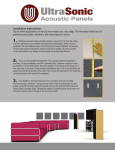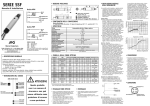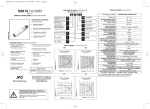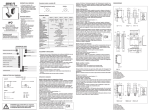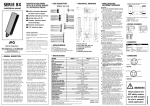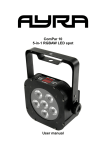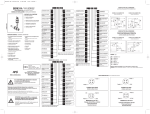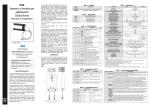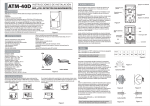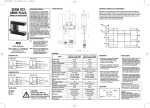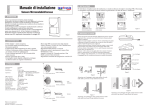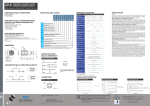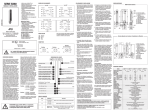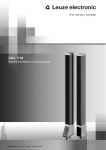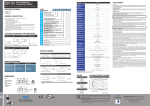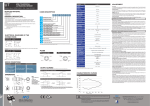Download SERIE DM Manuale di installazione
Transcript
1 Bn 2 Wh 4 Bk Ricevitore Uscita PNP +10-30 VDC + impulso luce n.c impulso buio - impulso buio carico 100mA 1 Bn +10-30 VDC n.c impulso luce - teach carico 100mA OV check + 10...30VDC 4 Bk 3 Bu check - 2 Wh n.c impulso luce - teach carico 100mA OV : : : : Brown/Marrone White/Bianco Blue/Blu Black/Nero N.B In caso di carico misto resistivo e capacitivo la massima capacità ammessa è di 0,1 μF per tensioni e correnti di uscita massime. OV www.microdetectors.com [email protected] • DESCRIZIONE DEL CODICE Serie Fotocellula cilindrica M12 Speciale DM 25 DMP e DME senza regolazione di sensibilità Uscita cavo Modelli riflessione diretta 100 mm senza regolazione di sensibiltà 2 A Uscita cavo assiale riflessione diretta 100 mm con regolazione di sensibilità 3 E Uscita connettore M12 riflessione diretta 200 mm senza regolazione di sensibiltà 5 riflessione diretta 300 mm con regolazione di sensibiltà 7 polarizzata 2 m con regolazione di sensibilità P emettitore 4 m con regolazione della potenza emessa ricevitore 4 m Contenitore 1 Uscita cavo, 4x0,14mm2, Ø3,75 mm, PVC, 2m Uscita connettore M12 metallico Pulsante di teach-in -Trimmer di regolazione Contenitore metallico Logica 0 emettitore E N uscita NPN R P uscita PNP Manuale di Installazione Due ghiere metalliche Accessorio regolazione trimmer ST82 per i modelli emettitori con regolazione della sensibilità • SPECIFICHE Tipo Distanza di rilevazione nominale Tolleranza Ripetibilità Tensione di alimentazione Ondulazione residua Corrente assorbita Corrente di uscita Corrente di perdita Caduta di tensione in uscita Tipo di uscita Frequenza di commutazione Ritardo alla disponibilità Protezioni elettriche alim. Protezioni elettriche uscita Deriva termica Interferenza alla luce esterna Grado di protezione DM2/0x-1x DM3/0x-1x DM5/0x-1x DM7/0x-1x DMP/0x-1x * DMP/0x-1x 25 * DMR/0x-1x DME/x0-1x DME/x0-1x 25 Riflessione diretta Polarizzata Barriera 100 mm 100 mm 200 mm 300 mm 2m 4m +15/-5% 5% 10 – 30 Vdc ≤ 10 % ≤ 20 mA 100 mA ≤ 10 μA (VDC max) NPN o PNP – NO/NC selezionabile 400 Hz Indicatore LED 0 emettitore con check X 250 Hz 150 ms Inversione di polarità , sovratensioni impulsive Al cortocircuito ( autoripristinante) 10%Sr 3000lux (lampada ad incandescenza); 10000lux (luce solare) IP67 (EN60529) Regolazione No Teach -in No Teach -in Teach -in No No Giallo No Trimmer Polarizzata. Montare il catarifrangente in modo che la sua superficie sia perpendicolare all’asse ottico del sensore. Assicurarsi che la distanza tra il sensore e il catarifrangente non sia superiore a quella specificata per il catarifrangente in uso. Fissare il sensore in modo stabile ma non definitivo e selezionare lo stato dell’uscita. Per ottenere un allineamento ottimale seguire la procedura seguente. Premere il pulsante di Teach o collegare il pin 2 (cavo bianco) a massa per t > 8sec. fino a quando il LED di segnalazione giallo non inizia a lampeggiare. La soglia viene posta al di sotto del segnale rilevato di una quantità pari all’isteresi. Regolare il sensore spostandolo verticalmente e orizzontalmente cercando di ottenere uno stato del LED acceso stabile o eventualmente una diminuzione della frequenza di lampeggio. Ripetere l’operazione fino a quando non sia più possibile variare la frequenza del lampeggio del LED. Fissare il sensore in modo stabile e verificare che interrompendo il fascio con l’oggetto da rilevare il LED si spenga. In tal modo si è realizzata una corretta centratura sul catarifrangente in uso e una regolazione fine della sensibilità del dispositivo. Tale regolazione risulta ottimale per la rilevazione precisa di oggetti semitrasparenti. Per le applicazioni in cui si devono intercettare oggetti non trasparenti ( dopo avere effettuato le operazioni precedentemente indicate) si consiglia di utilizzare la regolazione standard, in questo modo si avrà il massimo margine di immunità nei confronti della polvere e dello sporco che si può depositare sull’ ottica. Per ottenere una regolazione standard premere il pulsante di Teach o collegare il pin 2 (cavo bianco) a massa per 2…5 sec. fino a quando il LED non si riaccende in modo stabile. La soglia viene posta al 50% del segnale rilevato. Verificare che interrompendo il fascio con l’oggetto da rilevare il LED si spenga. Nel caso il LED giallo rimanga acceso occorre una regolazione fine della sensibilità. Note sulla regolazione digitale. Oltre la distanza nominale del sensore la regolazione fine non ha più influenza sulla distanza di intervento. Come si può vedere dalle curve seguenti l’isteresi aumenta all'aumentare della distanza di regolazione. Se occorre avere una regolazione fine è necessario utilizzare il sensore all'interno della distanza nominale di lavoro. Per verificare se il sensore è in grado di regolare la sensibilità correttamente , è consigliabile effettuare sempre una regolazione fine ed accertarsi dello stato lampeggiante del LED al termine della procedura. Se il LED rimane fisso , il sensore lavora ad una distanza troppo elevata in rapporto all’oggetto da rilevare o il sensore non è correttamente allineato. Se è sufficiente rilevare la presenza di oggetti e non si è influenzati da sfondi o altri oggetti dietro quello da rilavare, è possibile utilizzare il sensore fino alla distanza indicata nelle curve e nel caso ripetere la taratura effettuando una regolazione standard. Le curve indicano il rapporto tra la posizione in cui il sensore viene posto per effettuare la regolazione di sensibilità e la posizione in cui il sensore si attiva con margine >=2. 2V max. IL=100 mA Ingresso di check emettitore senza check NO/NC selezionabile Ottica scanner Ottica reflex • CONTENUTO DELLA CONFEZIONE Modello DM 2 / 0 0 - 1 A 25 Stato uscita CAT8DM1144401 +10-30 VDC + impulso buio 1/Bn 2/Wh 3/Blu 4/Blk +10-30 VDC 2 Wh Dichiarazione di conformità M.D. Micro Detectors S.p.A. con Unico Socio Dichiara sotto la propria responsabilità che questi prodotti sono conformi ai contenuti della direttiva CEE: 2004 /108/CE e ai successivi emendamenti. . 1 Bn CODICE COLORI 1 Bn Questo prodotto non è un sensore di sicurezza e non può essere utilizzato come protezione di accesso a zone pericolose. OV 3 Bu Emettitore ATTENZIONE n.c impulso buio - teach carico 100mA 4 Bk 3 Bu Fotocellula cilindrica M12 - DC Regolazione digitale della sensibilità mediante pulsante di teach-in o cavo remoto Led multifuzione con indicazione del livello del segnale Portata nominale: • Tasteggio diretto: 100, 200, 300 mm, polarizzata 2m, barriera 4m. • Emissione. Tasteggio diretto, barriera: infrarossa (880 nm) Polarizzata : rossa (660 nm) Materiale contenitore: ottone nichelato Uscita: NPN o PNP, 100 mA, con protezione al cortocircuito. 2 Wh Tasteggio diretto Uscita PNP +10-30 VDC + impulso buio 2 Wh • DESCRIZIONE GENERALE +10-30 VDC 3 Bu Tasteggio diretto Uscita NPN 1 Bn Tasteggio diretto Installare l’unità e selezionare lo stato dell’uscita. Posizionare l’oggetto da rilevare alla distanza di lettura desiderata , verificando che l’asse ottico sia perpendicolare alla superficie dell’oggetto. Assumendo le peggiori condizioni ( oggetto statisticamente più piccolo e oggetto o parte di esso più scura rispetto allo sfondo) posizionare l’oggetto nel punto più distante che può assumere rispetto al sensore. Premere il pulsante di teach o collegare il pin 2 (cavo bianco) a massa per 2…5 sec. fino a quando il LED di segnalazione giallo non si riaccende in modo stabile. La soglia viene posta al 50% del segnale rilevato e si ha una regolazione standard della sensibilità del dispositivo. Togliere l’oggetto e verificare lo spegnimento del LED giallo. Nel caso il LED giallo rimanga acceso occorre una regolazione fine della sensibilità . Per effettuare la regolazione fine collegare il pin 2 (cavo bianco) a massa o premere il pulsante di Teach per t > 8sec. fino a quando il LED di segnalazione giallo non inizia a lampeggiare, la soglia viene posta al di sotto del segnale rilevato di una quantità pari all’isteresi. Togliere l’oggetto e verificare lo spegnimento del LED giallo. + impulso luce 4 Bk OV 3 Bu Strada S.Caterina, 235 - 41122 Modena Italy Tel. +39 059 420411 Fax +39 059 253973 OV 1 Bn n.c impulso buio - teach carico 100mA n.c impulso buio - impulso buio carico 100mA Polarizzata Uscita PNP + impulso luce 2 Wh 4 Bk 2 Wh 3 Bu Polarizzata Uscita NPN Per i sensori a tasteggio diretto e polarizzati sono possibili due tipi di regolazione digitale della sensibilità : regolazione standard e regolazione fine. La regolazione fine è ottimale per ottenere la massima sensibilità nella rilevazione di oggetti piccoli e semitrasparenti; nel caso di oggetti opachi e di dimensioni maggiori o qualora lo sfondo non influenzi la lettura è conveniente utilizzare la regolazione standard , garantendo al sistema la possibilità di lavorare anche in ambienti gravosi. Per i sensori a barriera la regolazione di sensibilità è disponibile mediante trimmer. +10-30 VDC + impulso luce 4 Bk OV 3 Bu 4 Bk 1 Bn No Ingresso disaccoppiato 10 .. 30 Vdc : acceso fisso ( sensore in luce con ExG≥2 ) : lampeggiante (sensore in luce con 1≤ExG<2) : spento ( sensore in buio) • INSTALLAZIONE • Per facilitare il fissaggio sono disponibili le seguenti staffe opzionali : ST12-A , ST12C , ST04 • Evitare il deposito di materiali sull’ottica del sensore (come polvere, acqua, condensa …) che possano compromettere le caratteristiche di lettura. • Non usare alcool o prodotti chimici per pulire le parti ottiche. • Evitare che una luce di forte intensità o luce solare incida direttamente sull’ottica del sensore. • Serrare bene le ghiere nei modelli con uscita a connettore per evitare di compromettere il grado di protezione IP67 del sensore. Regolazione digitale con configurazione impulso buio Se è necessario utilizzare l’ingresso di Teach con una configurazione IMPULSO BUIO (DARK ON) si deve aggiungere un resistore di 2.2 KΩ per evitare il corto circuito con l’alimentazione quando il Teach è attivo 1 10...30 Vdc Posizionare gli elementi in modo tale che l’asse ottico sia il più possibile coincidente. Verificare che il trimmer di regolazione della sensibilità sia ruotato nell’estrema posizione oraria. Regolare l’emettitore spostandolo verticalmente e orizzontalmente fino ad ottenere l’accensione del LED giallo sul ricevitore. Regolare il ricevitore spostandolo verticalmente e orizzontalmente fino ad ottenere l’accensione stabile del LED giallo. Fissare definitivamente il sistema e procedere alla regolazione di sensibilità. Verificare in assenza di oggetto l’accensione stabile del LED giallo sul ricevitore. Ruotare in senso antiorario il trimmer di regolazione della sensibilità fino allo spegnimento del LED. Ruotare il trimmer in senso orario fino alla riaccensione stabile del LED di segnalazione. Questa posizione è quella che permette di lavorare in condizioni ottimali per rilevare con uguale precisione vuoti o pieni con buon margine di sicurezza. Se l’oggetto da rilevare non pone problemi è possibile ruotare il trimmer il senso orario fino all’estrema posizione per ottenere margini di lavoro più alti. Verificare che interrompendo il fascio luminoso il LED giallo sul ricevitore si spenga. Impulso luce/Impulso buio Ricevitore Uscita NPN • REGOLAZIONE DIGITALE DELLA SENSIBILITA’ Regolazione DM3 35 Doff carta bianca 30 25 20 Don carta nera Don carta bianca 15 10 Don carta nera 5 0 0 2 8 10 12 14 16 18 20 22 24 Regolazione DM7 Doff carta bianca 60 Doff carta nera 40 Don carta bianca Don carta nera 20 0 0 10 20 30 40 50 60 70 Distanza regolazione • CONNESSIONI 1 Assicurarsi che la tensione di alimentazione sia correttamente stabilizzata con una ondulazione residua (ripple) compresa all’interno dei dati di catalogo. 2 Utilizzando uno stabilizzatore di tensione di tipo “switching” assicurasi che il terminale di massa sia connesso a terra come il comune del sensore. 3 Nel caso che il rumore indotto dalle linee di potenza risulti superiore a quello previsto dalla normativa CE (immunità ai disturbi), separare i cavi del sensore dalle linee di potenza e di alta tensione e inserire il cavo in una canalina metallica connessa a terra. E’ consigliabile inoltre, collegare il sensore direttamente alla sorgente di alimentazione e non a valle di altri dispositivi. 4 Per estendere i cavi di alimentazione e uscita utilizzare un cavo avente conduttori di sezione minima di 1 mm2. Il limite dell’estensione in lunghezza è 100m (riferiti a tensione minima e corrente al carico di 100mA). 5 Lo stato del sensore diventa valido solo dopo 150 ms dalla fornitura di alimentazione (ritardo alla disponibilità). In questo periodo le uscite saranno OFF. Non utilizzare il segnale di uscita durante questo intervallo di tempo • CONNETTORI M12 (OUT) Tasteggio diretto Polarizzata Ricevitore Alimentazione (-) 4 3 1 2 Alimentazione (+) (check-) 2 Impulso luce/Impulso buio 3 OV 6 80 4 Uscita Emettitore / Ricevitore. Montare utilizzando le staffe consigliate emettitore e ricevitore in modo non definitivo, all’interno della distanza di rilevazione. 4 Distanza regolazione Impulso luce/Impulso buio Manuale di installazione • DISEGNI MECCANICI 2.2 K Ω SERIE DM • SCHEMI ELETTRICI DELLE CONNESSIONI Emettitore luce/buio/teach Alimentazione (-) 4 3 1 2 Alimentazione (+) (check+) +10-30 VDC 4 Bk 1 Bn + light on 2 Wh 1 Bn PNP - Diffuse Reflection +10-30 VDC + dark on 2 Wh 1 Bn OV WIRING COLORS 1 Bn 1/Bn 2/Wh 3/Blu 4/Blk +10-30 VDC 2 Wh check + 10...30VDC 4 Bk 3 Bu check OV These products are NOT safety sensors and are NOT suitable for use in personal safety application Declaration of conformity M.D. Micro Detectors S.p.A. con Unico socio Declare under our sole responsibility that these products are in conformity with the followingEEC directive: 2004 /108/EC and subsequent amendments. Brown White Blue Black • CODE DESCRIPTION Cable exit, 4x0,14mm2, Ø3,75 mm, PVC, 2m M12 metal plug cable exit Teach-in button / Trimmer Installation Manual Two M12 metal ring nut. Trimmer adjustment accessory ST82 for emitters with sensitivity adjustment • SPECIFICATIONS Models Type Nominal sensing distance Tolerance Repeat accuracy Operating voltage Ripple No-load current Load current Leakage current Output voltage drop Output type Switching frequency Special model Series M12 cylindrical photoelectric sensors DM 25 DMP and DME without sensitivity adjustment Models Cable exit diffuse reflection 100 mm without sensitivity adjustment 2 A axial cable exit diffuse reflection 100 mm with sensitivity adjustment 3 E M12 plug cable exit diffuse reflection 200 mm without sensitivity adjustment 5 1 Polarized 2m with sensitivity adjustment P Emitter 4m with power emission adjustment Receiver 4m E N NPN output R P PNP output Polarized Through-beam 100 mm 100 mm 200 mm 300 mm 2m 4m +15/-5% 5% 10 – 30 Vdc ≤ 10 % ≤ 20 mA 100 mA ≤ 10 μA (VDC max) NPN o PNP – NO/NC selectable 400 Hz Sensitivity Adjustement No Check input Output state LED indicators emitter without check – NO/NC selectable. 0 emitter with check X 250 Hz 150 ms Polarity reversal, transient Short circuit (autoreset) 10%Sr 3000lux (incandescent lamp); 10000lux (sunlight) IP67 (EN60529) Temperature drift Interference to external light Protection degree Teach -in No Teach -in Teach -in No Yellow No Sensitivity adjustment DM3 35 Doff white paper 30 25 20 Don black paper Don white paper 15 10 Don black paper 5 0 0 2 4 6 No Trimmer No Decoupled input 10 .. 30 Vdc : fixed on ( light state with ExG≥2 ) : blink (light state with 1≤ExG<2) : off ( dark state ) To aid fastening the following optional brackets are available :ST12-A , ST12C , ST04 Do not use the sensor where it may be exposed to dust, water, steam etc. which could affect detection. Do not use alcohol or chemical products to clean lens. Do not allow a strong light such as sun light to radiate directly on the sensor. On the models with plug cable exit the ring nuts must be tightened firmly to avoid impairing the sensor's protection degree IP67 1 10...30 Vdc 12 14 16 18 20 22 24 Doff white paper 60 Doff black paper 40 Don white paper Don black paper 20 0 0 10 20 30 40 50 60 70 Teach distance (cm) • CONNECTIONS 1 Make sure that the operating voltage is correctly stabilized with a maximum ripple being within the specified figure as stated in the catalogue. 2 When using a “switching” regulator for the power source be sure to earth both the frame round terminal and the sensor. 3 In the event that the noise induced by the power lines is greater than that specified by the EC regulation (interference immunity), detach the sensor cables from the power and high voltage lines and insert the cable in an earthed metal conduit. Furthermore, it is advisable to connect the sensor directly to the supply source and not downstream of other devices 4 To extend the supply and output cables, a cable with a minimum cross-section of 1 mm2 must be used. The length of such an extension is limit to a maximum of 100m (with respect to a minimum voltage and load current of 100mA). 5 The sensor will become active 150ms after supply voltage is applied. During this time, the outputs will be OFF. • M12 CONNECTORS (OUT) Diffuse reflection Polarized Receiver Supply (-) 4 3 1 2 Supply (+) 2 LOn/DOn Through-beam Using the recommended brackets, provisionally install the emitter and receiver within the sensing distance. Position the components so that they coincide with the optical axis as 10 Sensitivity adjustment DM7 80 4 Out 3 OV 8 Teach distance (cm) Teach with Dark ON configuration Should it be necessary to use the teach input with a DARK ON configuration 2.2 KΩ resistor must be added to avoid short circuits in the power supply when the teach mode is active. • INSTALLATION • • • • • Polarized Install the retro-reflector so that its surface is perpendicular to the sensor's optical axis. Make sure that the distance between the sensor and the retro-reflector is not greater than that specified for the retro-reflector in use. Provisionally secure the sensor in a stable position and select the output state. To achieve the best alignment, use the following procedure. Press the Teach button, or connect pin 2 (white cable) to earth for t > 8 secs., until the yellow signal LED starts flashing. The threshold is set below the detected signal of the hysteresis amplitude. Adjust the sensor by moving it vertically and horizontally until the LED switches on constantly, or at least until the frequency of the flashes decreases. Repeat the operation until it is no longer possible to vary the frequency at which the yellow LED flashes. Secure the sensor in a stable position and check that the LED switches off when the beam is interrupted by the target object. In this way a correct centring on the retro-reflector in use and a fine adjustment of device sensitivity have been carried out. This adjustment is ideal for the accurate detection of semi-transparent objects. For applications in which the target objects are not transparent, the standard adjustment is recommended (after having carried out the operations described above). This gives the highest possible margin of immunity to the dust or dirt which can deposit on the optical elements. To carry out a standard adjustment press the Teach button or connect pin 2 (white cable) to earth for 2-5 secs until the yellow signal LED switches back on constantly. The threshold is set at 50% of the detected signal. Check that the LED switches off when the beam is interrupted by the target object. If the yellow LED remains switched on, fine sensitivity adjustment is required. Digital adjustment notes. Beyond the nominal distance of the sensor, the fine adjustment has no effect on the operating distance. As shown from the curves, the hyteresis increases with a correspondent increase in the teach distance. If a fine adjustment is required, the sensor must be used within the nominal sensing distance. To check if the sensor is capable of adjusting the sensitivity correctly, it is always advisable to carry out a fine adjustment and to make certain that the LED is flashing at the end of the procedure. If the LED remains constant, either the sensor operates at too high distance in relation to the target object or the sensor is not correctly aligned. If it is sufficient only to detect the presence of objects and this is not affected by backgrounds or other objects behind those to be detected, the sensor can be used till the distance indicated in the curves is reached. If necessary, repeat the setting by carrying out a brief teach. The curves represent the relationship between the position in which the sensor is placed to carry out the sensitivity adjustment and the position in which the sensor is activated with a margin >=2. 2V max. IL=100 mA Output electrical protections Logic emitter diffuse reflection Supply electrical protections metal housing 0 DM2/0x-1x DM3/0x-1x DM5/0x-1x DM7/0x-1x DMP/0x-1x * DMP/0x-1x 25 * DMR/0x-1x DME/x0-1x DME/x0-1x 25 Time delay before availability Housing 7 Diffuse reflection optic Retroreflective optic • SUPPLIED MATERIAL DM 2 / 0 0 - 1 A 25 diffuse reflection 300 mm with sensitivity adjustment WARNING : : : : NOTE. In case of combined load, resistive and capacitive, the maximum admissible capacity is 0,1 μF for maximum output voltage and current www.microdetectors.com [email protected] M12 cylindrical photoelectric sensors - DC Digital sensitivity adjustment by teach-in button or remote cable Multifunction LED with signal level indication Sensing distance : • Diffuse reflection 100, 200, 300 mm , polarized 2m, through-beam 4m. • Emission. Diffuse reflection , through-beam: infrared ( 880 nm) Polarized : red (660 nm) Housing Material : nickel-plated brass Output : NPN or PNP, 100 mA , with short circuit protections. OV 3 Bu Emitter • GENERAL DESCRIPTION n.c light on - teach Load 100mA 4 Bk 3 Bu Strada S.Caterina, 235 - 41122 Modena Italy Tel. +39 059 420411 Fax +39 059 253973 +10-30 VDC + dark on 2 Wh n.c light on - teach Load 100mA OV 3 Bu NPN - Diffuse Reflection 1 Bn n.c dark on - teach Load 100mA 4 Bk OV 3 Bu 4 Bk +10-30 VDC + light on 2 Wh n.c dark on - teach Load 100mA Diffuse reflection Install the unit and select the output state. Position the target object at the sensing distance required, checking that the optical axis is perpendicular to the surface of the object. Assuming the worst possible conditions (object smaller and object or part of object darker than the background), position the object at the furthest possible point from the sensor. Press the teach button or connect pin 2 (white cable) to earth for 25 secs. until the yellow signal LED switches back on constantly. The threshold is set at 50% of the detected signal, thus giving the device a standard sensitivity adjustment. Remove the object and check that the yellow LED has switched off. If the yellow LED remains switched on, fine sensitivity adjustment is required. To carry out the fine adjustment connect pin 2 (white cable) to earth or press the Teach-in button for t > 8 secs. until the yellow signal LED starts flashing. The threshold is set below the detected signal of the hysteresis amplitude. Remove the object and check that the yellow LED has switched off. PNP - Polarized +10-30 VDC + light on 2 Wh OV 3 Bu NPN - Polarized 1 Bn n.c dark on - dark on Load 100mA 4 Bk OV 3 Bu 4 Bk +10-30 VDC + light on 2 Wh n.c dark on - dark on Load 100mA Two types of digital sensitivity adjustment are possible on the diffuse reflection and polarized sensors: standard adjustment and fine adjustment . Fine adjustment is ideal for achieving the greatest sensitivity for the detection of small and semitransparent objects; if the target objects are opaque or of larger dimensions, or if the background does not affect the reading, standard adjustment should be used as it guarantees that the system can operate in harsh environments. On the through beam sensors sensitivity adjustment is available by means of a trimmer. PNP - Receiver much as possible. Check that the sensitivity adjustment trimmer is turned to the furthest clockwise position. Adjust the emitter by moving it vertically and horizontally until the yellow LED on the receiver switches on. Adjust the receiver by moving it vertically and horizontally until the yellow LED switches on constantly. Secure the system properly and proceed with the sensitivity adjustment. Check that, when no object is present, the yellow LED on the receiver is constantly switched on. Turn the sensitivity adjustment trimmer in an anticlockwise direction until the LED switches off. Turn the trimmer in a clockwise direction until the signal LED switches back on constantly. This is the position in which the system can operate in the optimum conditions for detecting both solid parts and spaces with equal precision and with a good safety margin. If the target object does not create problems, the trimmer can be turned clockwise to the furthest position to achieve higher working limits. Check that the yellow LED on the receiver switches off when the optical beam is interrupted. Don/Doff (cm) 1 Bn • SENSITIVITY ADJUSTMENT Don/Doff (cm) Installation Manual NPN - Receiver • MECHANICAL DRAWINGS 2.2 K Ω SERIES DM • WIRING DIAGRAMS light/dark/teach (check-) Emitters Supply (+) Supply (-) 4 3 1 2 (check+)


